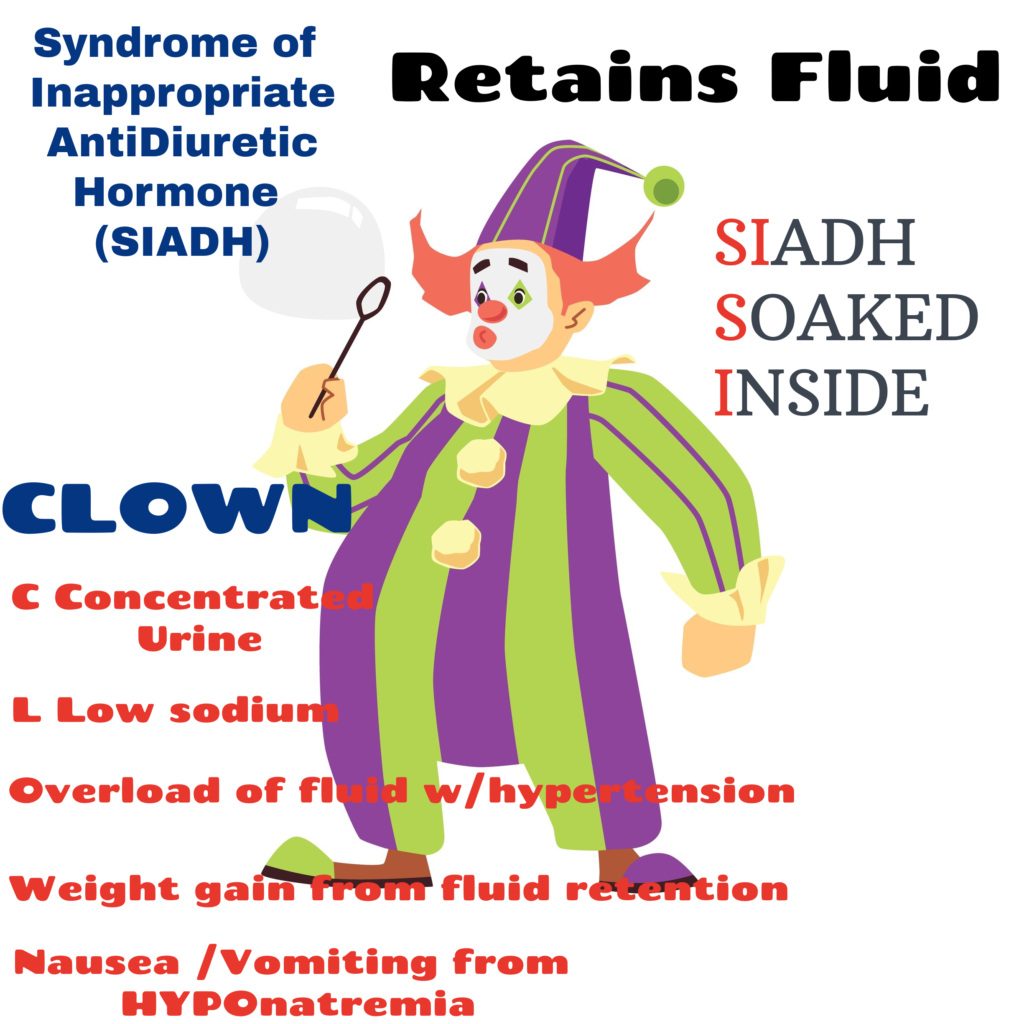Syndrome of Inappropriate AntiDiuretic Hormone
Syndrome of Inappropriate AntiDiuretic Hormone (SIADH) is TOO MUCH ADH. You are storing all your water and become SOAKED INSIDE. On the NCLEX, you may see a client with a pituitary tumor who develops SIADH. Due to the tumor, the pituitary gland is releasing ADH in excess. The best position for this client is bed flat which enhances venous return to the heart and increases the left arterial filling pressure, thereby reducing the release of antidiuretic hormone. Bed should not be elevated more than 10 degrees.
/*! elementor – v3.12.1 – 02-04-2023 */
.elementor-widget-image{text-align:center}.elementor-widget-image a{display:inline-block}.elementor-widget-image a img[src$=”.svg”]{width:48px}.elementor-widget-image img{vertical-align:middle;display:inline-block} 
HOB flat or < 10 degrees in pituitary tumors

/*! elementor – v3.12.1 – 02-04-2023 */
.elementor-accordion{text-align:left}.elementor-accordion .elementor-accordion-item{border:1px solid #d5d8dc}.elementor-accordion .elementor-accordion-item+.elementor-accordion-item{border-top:none}.elementor-accordion .elementor-tab-title{margin:0;padding:15px 20px;font-weight:700;line-height:1;cursor:pointer;outline:none}.elementor-accordion .elementor-tab-title .elementor-accordion-icon{display:inline-block;width:1.5em}.elementor-accordion .elementor-tab-title .elementor-accordion-icon svg{width:1em;height:1em}.elementor-accordion .elementor-tab-title .elementor-accordion-icon.elementor-accordion-icon-right{float:right;text-align:right}.elementor-accordion .elementor-tab-title .elementor-accordion-icon.elementor-accordion-icon-left{float:left;text-align:left}.elementor-accordion .elementor-tab-title .elementor-accordion-icon .elementor-accordion-icon-closed{display:block}.elementor-accordion .elementor-tab-title .elementor-accordion-icon .elementor-accordion-icon-opened,.elementor-accordion .elementor-tab-title.elementor-active .elementor-accordion-icon-closed{display:none}.elementor-accordion .elementor-tab-title.elementor-active .elementor-accordion-icon-opened{display:block}.elementor-accordion .elementor-tab-content{display:none;padding:15px 20px;border-top:1px solid #d5d8dc}@media (max-width:767px){.elementor-accordion .elementor-tab-title{padding:12px 15px}.elementor-accordion .elementor-tab-title .elementor-accordion-icon{width:1.2em}.elementor-accordion .elementor-tab-content{padding:7px 15px}}.e-con-inner>.elementor-widget-accordion,.e-con>.elementor-widget-accordion{width:var(–container-widget-width);–flex-grow:var(–container-widget-flex-grow)}
Causes of SIADH
- Brain causes: injury, surgery, tumors, infection, TCA’s, nicotine
- Lung cancer patients are at the highest risk
- Low, concentrated urine with high specific gravity >1.030
- Hypoosmolality and hyponatremia due to dilution since patient retaining fluid.

- Think of Osmolality as concentration. 275-295 mOsm/kg for serum osmolality
- Urine osmolality more variable 50-1200 mOsm/kg
- In SIADH, urine is very concentrated so it has high osmolality > 1200
- Patient retains fluid, so serum has low osmolality <275
High specific gravity since it is concentrated. Makes little urine.
- Hyponatremia
- Retaining fluid so serum sodium is diluted!
- Seizures precautions (watch for headache and confusion).
- Restrict fluids
- Diuretics (furosemide)
- Vasopressin antagonists
- Monitor Weight

The clearer the urine, the lowest the specific gravity. DI’s urine has Low specific gravity <1.010 (Normal 1.010-1.030)
Darker urine has high specific gravity. SIADH retains all the water and pees concentrated with Specific gravity > 1.030
DI makes urine with low osmolality and since it is dry inside, serum osmolality is high
SIADH makes urine with high osmolality (concentrated) and since it is soaked inside, serum osmolality is low.
